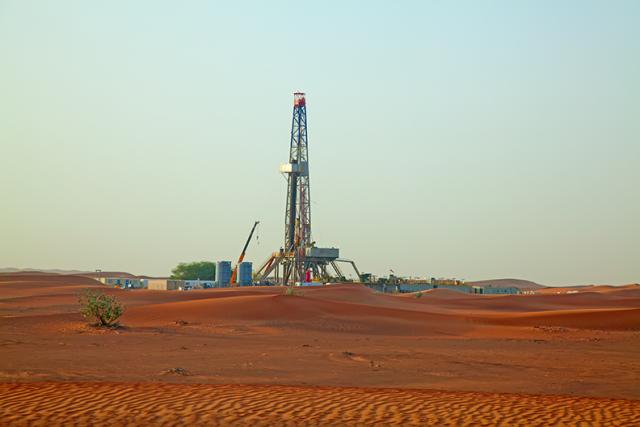
An oil well in the desert in the United Arab Emirates. (Source: Shutterstock.com)
For more than a decade OPEC has stated that an element of its policy is to stabilize volatility in global crude prices through buffer capacity in the case of disruptions. Authors Axel Pierru, James Smith (SMU), and Tamim Zamrik recently published a study for The King Abdullah Petroleum Studies and Research Center (KAPSARC), based in Riyadh, Saudi Arabia, analyzing the size and impact of this capacity on oil prices.
The authors looked at how effective OPEC has been in estimating the size of oil market shocks, as well as “execution errors and constraints when implementing production decisions.” Focusing on data from September 2001 to October 2014, they found that “OPEC has the ability (at least in theory) to stabilize the price of oil,” and that Saudi Arabia on its own, or the OPEC subgroup of its Four GCC members, have the same ability. A look at data from periods when OPEC has drawn upon its spare capacity reaches the same conclusion, according to the study, published in The Energy Journal.
“Under plausible assumptions regarding the elasticity of demand, OPEC’s stabilizing influence appears to have been very substantial, perhaps reducing oil price volatility by as much as half,” according to the authors. Overall, the study found that “the estimated size of OPEC’s buffer has been in line with global macroeconomic needs.”
The authors addressed the fact that the study is based on date only up to October 2014. “We do not overlook the strategic change within OPEC in late 2014 to rebalance the market, but that episode followed the end of our sample period. In any event, OPEC appears to have resumed its role in helping to stabilize the market, albeit at a lower price.”
Adam Sieminski, KAPSARC president, in mid-July issued a commentary on the results, noting that rising oil prices and heightened geopolitical uncertainty had “put OPEC’s spare production capacity back into the spotlight,” and that the KAPSARC study found that this capacity “generates between $170 billion and $200 billion of annual economic benefits for the global economy.”
According to IEA data, Saudi Arabia has held an average of 70% of OPEC’s total spare capacity since 2001, Sieminski noted. “The analysis confirms that OPEC’s buffer, estimated at 2.64 MMbbl/d (1.94 MMbbl/d for Saudi Arabia) has been in line with global macroeconomic needs.”
Sieminski addressed the impact that U.S. shale oil has had on the market now that it stands as the world’s marginal producer, noting that it has made non-OPEC supply much more reactive to price. “By contributing to market stability, shale oil is capturing a share of the historical value of spare capacity for the world economy and reducing the incentive for OPEC members to invest in maintaining the cushion.”
But, he said, shale oil can be hamstrung by logistical factors, such as the current constraints in the Permian Basin, and it can’t rapidly offset unanticipated shocks of large magnitude. “As such it does not provide sufficient protection for the world economy, and OPEC spare capacity still provides value in stabilizing oil markets,” he concluded.
Recommended Reading
McKinsey: Big GHG Mitigation Opportunities for Upstream Sector
2024-11-22 - Consulting firm McKinsey & Co. says a cooperative effort of upstream oil and gas companies could reduce the world’s emissions by 4% by 2030.
Water Management Called ‘Massive Headwind’ for Permian Operators
2024-11-21 - Amanda Brock, CEO of Aris Water Solutions, says multiple answers will be needed to solve the growing amounts of produced water generated by fracking.
Matador May Tap Its Haynesville ‘Gas Bank’ if Prices Stabilize
2024-10-24 - The operator holds 8,900 net Haynesville Shale acres and 14,800 net Cotton Valley acres in northwestern Louisiana, all HBP, that it would drill if gas prices stabilize—or divest for the right price.
Chevron Pushing Longer Laterals in Argentina’s Vaca Muerta Shale
2024-09-13 - Chevron Corp., already drilling nearly 2.8-mile laterals at its Loma Campana Field in Argentina, wants to drill even longer horizontals, an executive told Hart Energy.
Nabors Takes to Global Expansion in 3Q as Rig Count Shrinks in Lower 48
2024-10-25 - Nabors Industries saw broad growth across key international geographies in third-quarter 2024, with more rig deployments expected.
Comments
Add new comment
This conversation is moderated according to Hart Energy community rules. Please read the rules before joining the discussion. If you’re experiencing any technical problems, please contact our customer care team.






